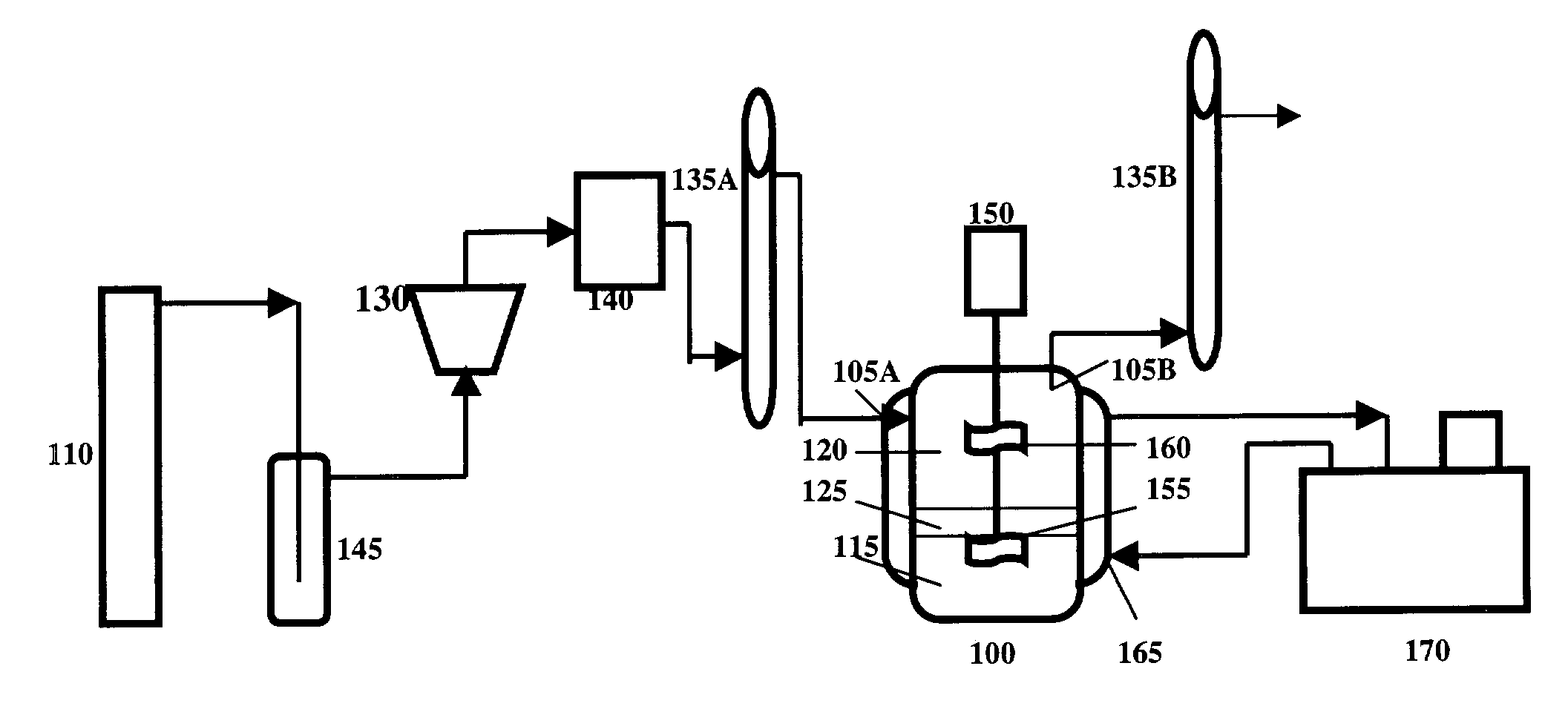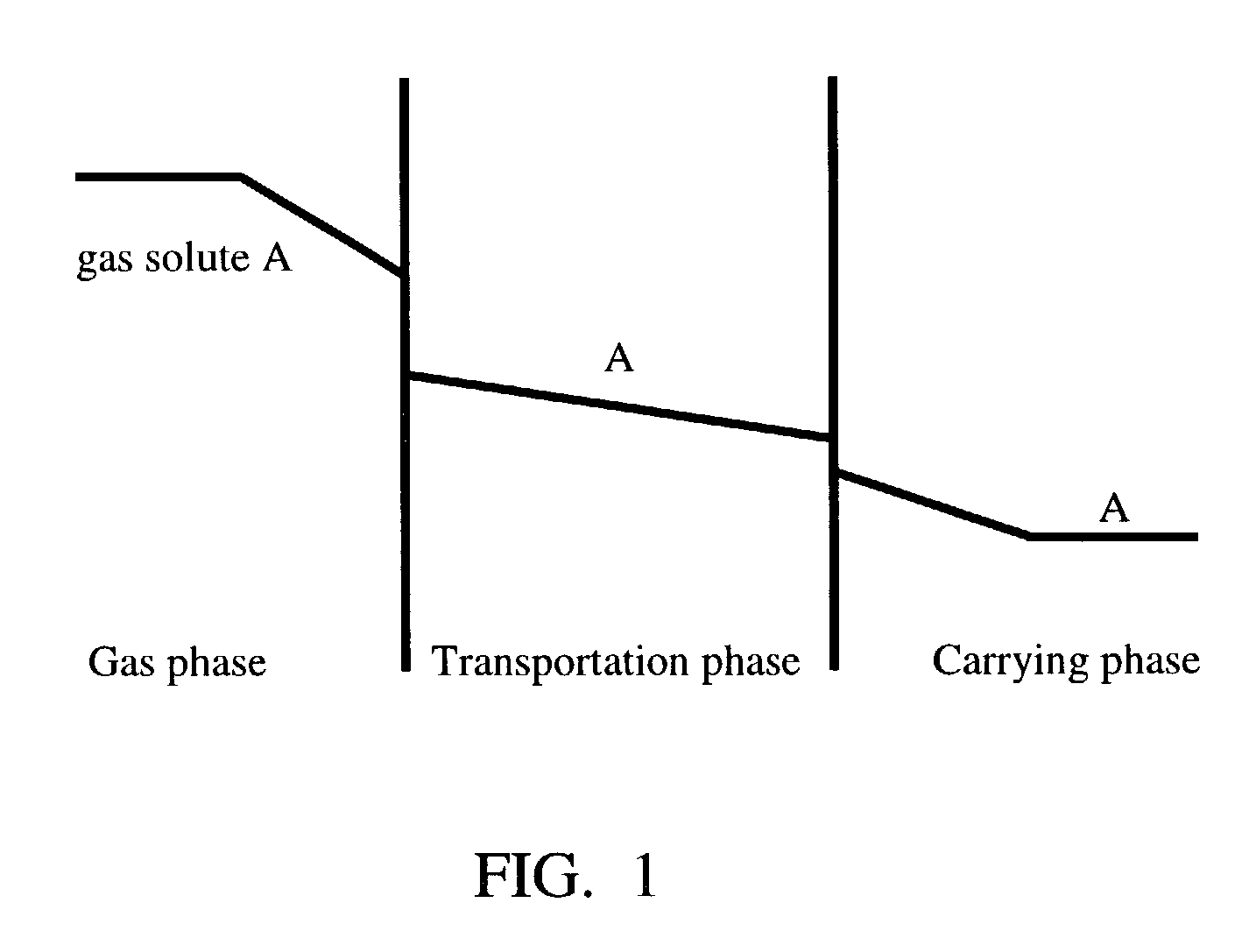Phase enhanced gas-liquid absorption method
a phase enhanced and gas technology, applied in the field of gas separation, can solve the problems of reducing the mass transfer resistance, increasing the mass transfer coefficient, and hindering the release of absorbed gas from liquid solution, so as to improve the mass transfer efficiency of the system, improve efficiency, and increase the gas absorption rate significantly
- Summary
- Abstract
- Description
- Claims
- Application Information
AI Technical Summary
Benefits of technology
Problems solved by technology
Method used
Image
Examples
example 1
An Absorption System
[0043]In this particular example of a phase enhanced gas-liquid absorption system, a stirring cell was used as a reaction vessel. The structure of the cell is shown in FIG. 3. The stirring cell was made of glass with 100 mm inner diameter and 130 mm depth. Two agitating blades, one for the liquid carrier and the other for the gas mixture, were driven by a direct-current motor. The speeds of the agitating blades were determined by a laser meter. The temperature of the reaction vessel was controlled by a water jacket (not shown).
[0044]FIG. 4 is a flow chart of the system. Carbon dioxide from a cylinder 205 passed through a regulator 210, a buffer bottle 215, and a pressure stabilizing tube 220. Gas flow rate was controlled and measured by rotating flow meters 225, 230. A gas cleaning system consisted of U tubes 235, 240. The U tube 235 was filled with silicon gel while the U tube 240 contained active carbon. The gas was saturated with moisture by a bottle 243 which...
example 2
Analytical Method for Determining Absorbed Gas for the System of Example 1
[0046]The absorption rate of carbon dioxide at time t was determined by the difference of flow rates at the inlet and outlet of the reaction vessel, which were measured by the foam film flow meters 250 and 255. From the results of the measurements over a given time period, the relationship between the absorption rate r and time t was established. By integrating the absorption rate r over time t for the time period, the total amount of carbon dioxide absorbed in the liquid phase was obtained.
[0047]The concentration of carbon dioxide in the liquid carrier can be determined by using the ideal gas law. Carbon dioxide was collected upon being released from the liquid carrier by adding sulfuric acid. The mass of carbon dioxide was then computed. The mass of carbon dioxide obtained from integrating the absorption rate r over time t should be equal to the mass of carbon dioxide computed according to the ideal gas law ...
example 3
The Results of the CO2-sodium Formate Aqueous Solution Absorption System
[0048]In this example, two experiments were conducted. In the first experiment, carbon dioxide was absorbed by 280 ml sodium formate aqueous solution (400 g / l) and 20 ml organic mixture of Alamine 336 and 2-ethylhexyl alcohol (1:1 by volume). In the second experiment, carbon dioxide was absorbed by 300 ml sodium formate aqueous solution (400 g / l) directly.
[0049]In the first experiment, 280 ml sodium formate aqueous solution (400 g / L) and 20 ml liquid organic mixture were added into the reaction vessel. The liquid organic mixture, which was immiscible with the aqueous solution, formed a layer, as a second liquid phase, on top of the liquid carrier. The liquid carrier was agitated gently to facilitate the diffusion or dissolving of the gas. Agitating was sufficiently gentle so the convection moment it created did not break or destroy the layer of the liquid organic mixture. Carbon dioxide from the gas had to pass ...
PUM
 Login to View More
Login to View More Abstract
Description
Claims
Application Information
 Login to View More
Login to View More - R&D
- Intellectual Property
- Life Sciences
- Materials
- Tech Scout
- Unparalleled Data Quality
- Higher Quality Content
- 60% Fewer Hallucinations
Browse by: Latest US Patents, China's latest patents, Technical Efficacy Thesaurus, Application Domain, Technology Topic, Popular Technical Reports.
© 2025 PatSnap. All rights reserved.Legal|Privacy policy|Modern Slavery Act Transparency Statement|Sitemap|About US| Contact US: help@patsnap.com



